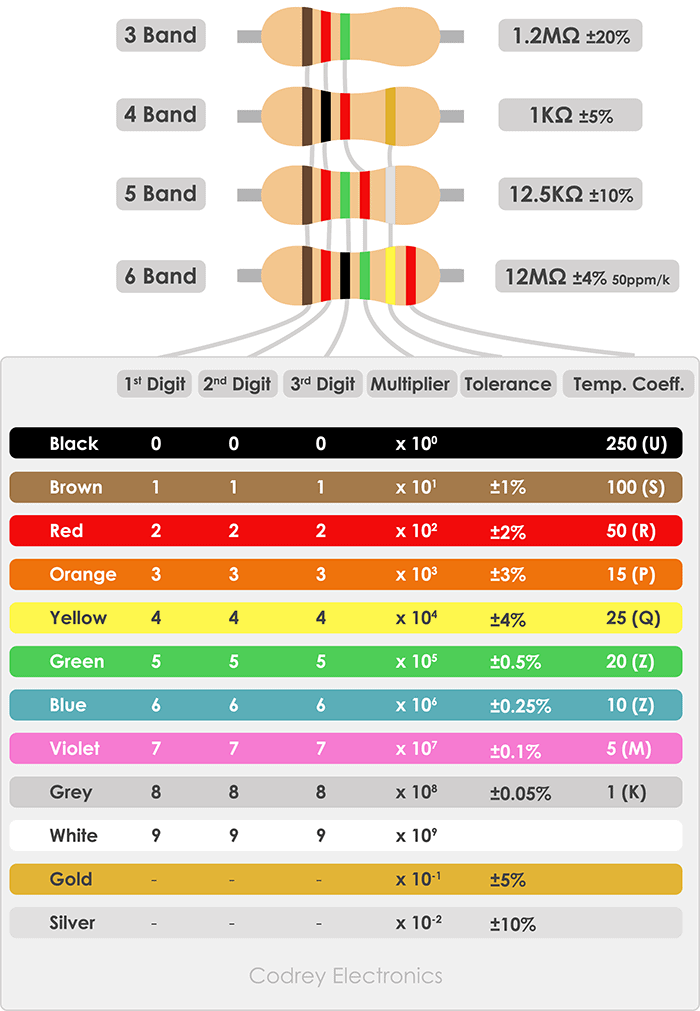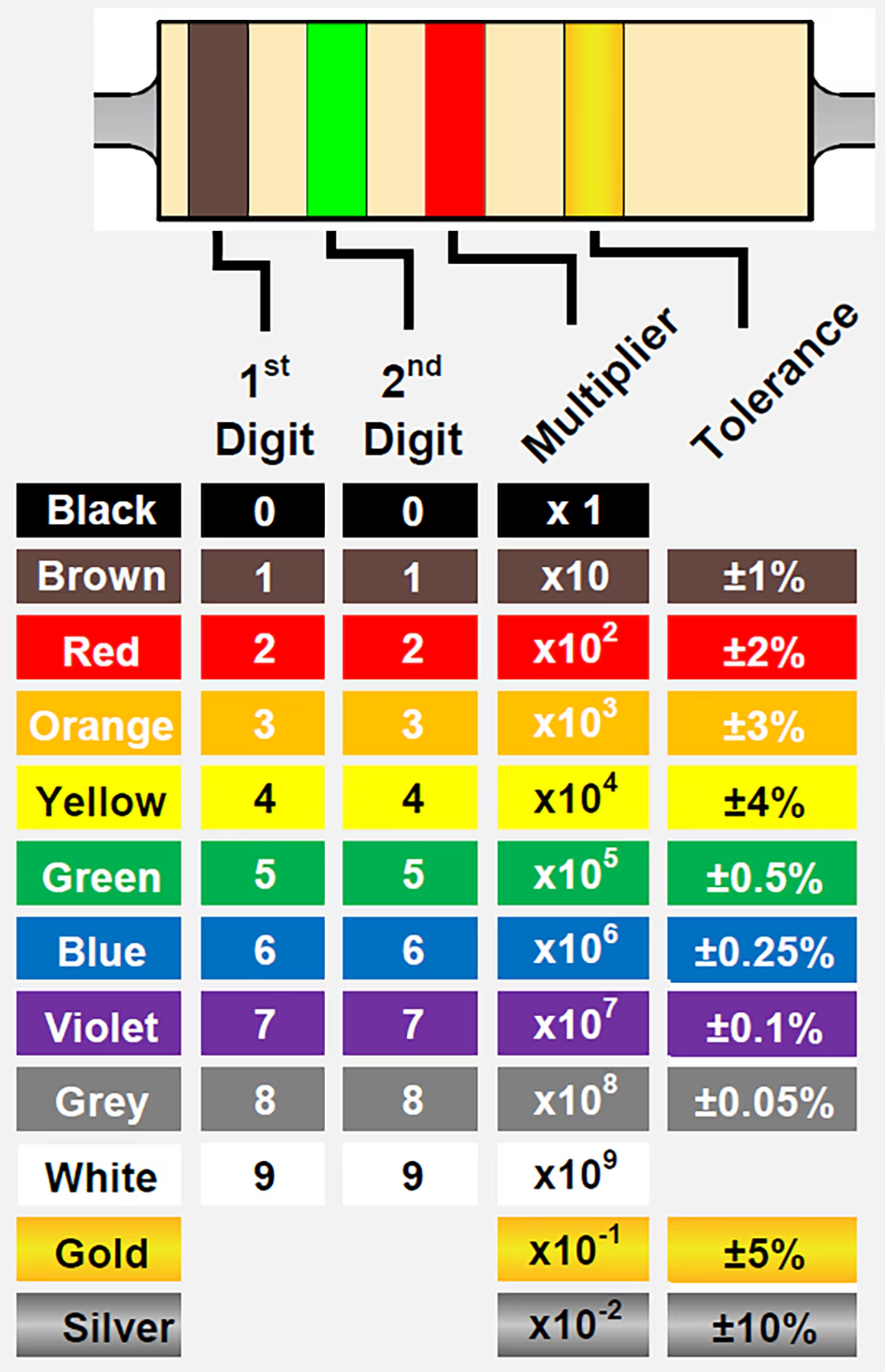Resistor Color Code Calculator — A Complete Informational Guide
Resistors are fundamental components in electronic circuits used to control current, divide voltages, and protect sensitive parts. Instead of printing numeric values on the small body of many resistors, manufacturers mark them with a set of colored bands. The resistor color code maps those bands to digits, multipliers, tolerance, and sometimes temperature coefficient.
This guide explains how to read color bands, how the resistor color code calculator works, manual examples (4‑, 5‑, and 6‑band resistors), common mistakes, and related terminology you should know.
What Is a Resistor Color Code?
The resistor color code is an international convention (based on IEC 60062) that assigns specific colors to numeric values and multipliers. By reading the bands in the correct direction, you can determine the nominal resistance and tolerance without a meter.
Band Types and Their Meaning
Resistors commonly have between 3 and 6 bands. Each configuration provides a different level of precision:
| Band Count | Common Use | Structure | Meaning |
|---|---|---|---|
| 3-band | Low precision | Digit 1 – Digit 2 – Multiplier | Tolerance typically ±20% |
| 4-band | General-purpose | Digit 1 – Digit 2 – Multiplier – Tolerance | Most common |
| 5-band | Precision resistors | Digit 1 – Digit 2 – Digit 3 – Multiplier – Tolerance | Higher resolution |
| 6-band | High-precision / temp-sensitive | Digit 1 – Digit 2 – Digit 3 – Multiplier – Tolerance – Temp. coeff. | Includes temperature coefficient (ppm/°C) |
Color-to-Number Reference Table
Use this quick reference for manual decoding and to verify calculator output.
| Color | Digit | Multiplier | Tolerance | Temp. Coefficient |
|---|---|---|---|---|
| Black | 0 | ×10⁰ | — | — |
| Brown | 1 | ×10¹ | ±1% | 100 ppm/°C |
| Red | 2 | ×10² | ±2% | 50 ppm/°C |
| Orange | 3 | ×10³ | — | 15 ppm/°C |
| Yellow | 4 | ×10⁴ | — | 25 ppm/°C |
| Green | 5 | ×10⁵ | ±0.5% | 20 ppm/°C |
| Blue | 6 | ×10⁶ | ±0.25% | 10 ppm/°C |
| Violet | 7 | ×10⁷ | ±0.1% | 5 ppm/°C |
| Gray | 8 | ×10⁸ | ±0.05% | — |
| White | 9 | ×10⁹ | — | — |
| Gold | — | ×10⁻¹ | ±5% | — |
| Silver | — | ×10⁻² | ±10% | — |

Complete Resistor Color Code Reference Chart

4 and 5 Band Resistor Examples
How to Use the Resistor Color Code Calculator
- Select the number of bands on the resistor (3, 4, 5, or 6).
- Choose the color for each band using the provided controls.
- The calculator converts colors to digits, applies the multiplier, and shows the nominal resistance, tolerance, and temperature coefficient (if present).
- Optionally view the minimum and maximum resistance range based on tolerance.
Tip: Always double-check orientation — start reading from the end opposite the tolerance band (gold or silver is usually on the right).
Use the Resistor Color Code Calculator on this site to decode bands instantly.
Manual Calculation Examples
4-Band Example
Colors: Yellow – Violet – Red – Gold

Digits: 4 (Yellow), 7 (Violet). Multiplier: ×10² (Red). Tolerance: ±5% (Gold).
Calculation: (47) × 100 = 4,700 Ω (4.7 kΩ). Range: 4,455 Ω to 4,945 Ω.
5-Band Example
Colors: Brown – Black – Black – Red – Brown
Digits: 1,0,0. Multiplier: ×10². Tolerance: ±1%.
Calculation: 100 × 100 = 10,000 Ω (10 kΩ). Range: 9,900 Ω to 10,100 Ω.
6-Band Example
Colors: Green – Blue – Black – Red – Brown – Red
Digits: 560. Multiplier: ×10². Tolerance: ±1%. Temp coefficient: 50 ppm/°C.
Calculation: 560 × 100 = 56,000 Ω (56 kΩ) ±1% with 50 ppm/°C.
Common Mistakes and Troubleshooting
- Wrong reading direction: Read from the end with the band cluster; the tolerance band is usually on the right.
- Gold/Silver confusion: These denote multiplier or tolerance, not digits.
- No tolerance band: Default tolerance is typically ±20%.
- Faded colors: Use a multimeter when color bands are worn or ambiguous.
- Band count error: Confusing a 5-band for a 4-band resistor will produce an incorrect value.
FAQ
- What does a resistor color code calculator do?
- It converts the color bands on a resistor into numeric digits, applies the multiplier, and returns the nominal resistance, tolerance, and temperature coefficient (if present).
- What is a 3-band resistor?
- A 3-band resistor has two significant digits and a multiplier. Tolerance is typically ±20% unless a tolerance band is shown.
- Why are there 5-band and 6-band resistors?
- They provide higher precision and additional data such as temperature coefficient, which is important for precision circuits and temperature-sensitive applications.
- What if the color bands are faded?
- Measure the resistor with a digital multimeter or consult the manufacturer's datasheet for that part.
- Is the color code system universal?
- Yes. The IEC 60062 standard is widely used by manufacturers worldwide.